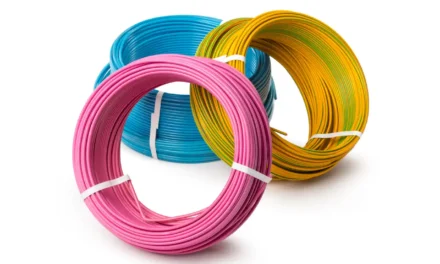Busbars are essential components in control panel boards, playing a crucial role in the distribution of electrical power within the panel and across an electrical system. They are essentially conductive strips, bars, or bus tubes that carry and distribute large amounts of electrical current from one part of the control panel to various circuit breakers, fuses, or other connected devices. Busbars are typically made from highly conductive materials like copper, aluminum, or brass.
1. Power Distribution
- Efficient Power Transmission: Busbars provide a centralized path for distributing electrical power from the incoming supply to the various circuits, ensuring the efficient flow of electricity. They act as a distribution hub within the control panel, where incoming electrical power is routed to individual circuit breakers, fuses, and devices.
- Reduced Wiring Complexity: Instead of running individual wires for each circuit, busbars simplify wiring by acting as a common distribution point for multiple circuits. This reduces the clutter of cables and makes the system cleaner, more organized, and easier to maintain.
2. Handling High Current Loads
- High Current Capacity: Busbars are designed to carry high current loads, which are common in industrial and commercial electrical systems. They are typically much more capable of handling higher currents than individual wires and cables.
- Safety: By using busbars, the overall current-carrying capacity is evenly distributed, reducing the risks of overheating or fire that could occur with inadequate wiring. Proper busbar sizing ensures the electrical system operates safely under normal loads.
3. Simplified Circuitry
- Reduced Wiring Complexity: Busbars eliminate the need for extensive wiring that would otherwise be necessary to connect each individual device or component. This simplification of wiring reduces the chances of wiring errors and helps streamline the overall control panel design.
- Ease of Maintenance: With busbars, maintenance becomes easier, as each circuit is connected directly to the busbar, making it easier to troubleshoot and isolate faults in the system.
4. Flexibility in Design
- Modular Design: Busbars allow for more flexible and modular design in control panels. New circuits or additional devices can be easily added to the busbar without the need for a complete redesign of the entire panel.
- Space Efficiency: Busbars reduce the need for excessive wiring and connectors, making the overall control panel more compact and efficient in terms of space utilization.
5. Heat Dissipation
- Effective Cooling: Busbars are designed to have large surface areas that help dissipate heat generated by the current flowing through them. Properly designed busbars allow for efficient cooling, reducing the risk of overheating, which can damage components or reduce the lifespan of the electrical system.
6. Fault Isolation
- Easier Fault Detection: If a fault occurs, such as an overload or short circuit, the busbar can be designed to make it easy to isolate the affected section of the system. With proper labeling and segmentation, you can pinpoint the faulty circuit more quickly, making troubleshooting and repairs more efficient.
- Protecting Circuits: The busbar allows for the integration of fuses or circuit breakers that can protect individual circuits from faults. By isolating circuits that are overloading or malfunctioning, the busbar helps prevent damage to the overall system.
7. Cost-Effective Solution
- Reduced Material Costs: Busbars are generally more cost-effective for distributing electrical power compared to running a separate set of wires for each circuit. The use of busbars reduces material costs, especially in larger panels or systems with multiple circuits.
- Fewer Components: Busbars reduce the need for multiple terminals, connectors, and wiring runs, which can be both costly and time-consuming to install. This simplifies the construction process of control panels.
8. Customization and Adaptability
- Customization for Specific Applications: Busbars can be customized in terms of material, shape, size, and design to suit specific power distribution needs. Depending on the application, the busbar can be designed for low-voltage or high-voltage systems, or tailored for specific environments like hazardous or corrosive conditions.
- Expandable: As electrical demands change, busbars in control panel boards can be easily adapted or expanded to accommodate additional circuits, making them a long-term solution for growing systems.
9. Reliability and Durability
- Long-Term Reliability: Due to their robust design, busbars have high reliability and durability. Properly sized and installed busbars will serve effectively over long periods, reducing the need for frequent replacements or repairs.
- Reduced Connection Failures: Because busbars have fewer connection points than traditional wiring, there is less likelihood of connection failures, which can improve the overall reliability of the electrical system.
10. Compliance with Standards
- Adherence to Electrical Codes: Busbars are designed and manufactured to comply with international electrical standards and safety regulations (e.g., IEC, UL, etc.), ensuring that the electrical system meets the necessary safety and performance requirements.
- Standardization: Busbars help in standardizing electrical systems, making installation and upgrades easier while ensuring uniformity and compliance across various systems.
Busbars are integral components of control panel boards, offering efficient power distribution, simplicity in design, and safety for electrical systems.














